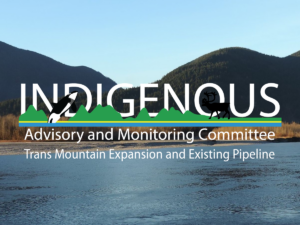Updates
Latest Updates and News

IAMC-TMX Indigenous Caucus, Canada Energy Regulator and Trans Mountain Endorse Field Discussion Process
November 22, 2022 – Vancouver, BC – The IAMC-TMX Indigenous Caucus, Canada Energy Regulator (CER) and Trans Mountain have co-developed…
Read MoreIndigenous Advisory and Monitoring Committee for the Trans Mountain Expansion Project and Existing Pipeline 1. Purpose of the Expression of…
Read MoreIAMC-TMX Indigenous Monitors Complete First-ever Joint Inspection with the B.C.EAO
June 30, 2022 – Vancouver, BC The Indigenous Advisory and Monitoring Committee for the Trans Mountain Expansion and Existing Pipeline…
Read MoreINTENT The Socioeconomic Subcommittee (SESC) of the Indigenous Advisory and Monitoring Committee for the Trans Mountain Expansion Project and Existing…
Read MoreHonouring the Roots of Indigenous Oversight This National Indigenous History Month, we reflect on the powerful origins of the IAMC-TMX. It began in 2017 with a letter to the Prime Minister — a call from leaders Chief Ernie Crey and Chief Aaron Sumexheltza to create a new model of Indigenous-led oversight. Today, that vision endures through our subcommittees, our Indigenous Monitors, our partnerships with regulators, and our ongoing commitment to protecting lands, waters, and communities. We honour those who stood up, spoke out, and continue to lead the way. Learn more: www.iamc.ca Photo credit: Mary Fowles
We’re Making History — Together This National Indigenous History Month, the IAMC proudly celebrates the transformative work of our Indigenous Monitors Program — a program built by Indigenous People, for Indigenous oversight. Since 2019, Indigenous Monitors from communities along the Trans Mountain Expansion Project (TMX) have been exercising their rights and responsibilities to protect the lands, waters, and sacred places along the route. Our Monitors bring Indigenous knowledge, ceremony, and law to their roles, working towards development done with respect, accountability, and care. The Indigenous Monitoring program is the first of its kind, not only in Canada but also globally. This is not just monitoring. This is Indigenous leadership in action. This is reconciliation in practice. This is history — and we are honoured to be making it together. Photo credits: Mary Fowles and Earl Belcourt
Request for Proposal The IAMC-TMX is seeking proposals for the administration of the selection process for the Alberta Métis representative to the IAMC-TMX Indigenous Caucus. Proposals must be submitted by June 16, 2025. For more information, please visit www.iamc.ca/request-for-proposal-administration-of-the-selection-process-for-the-alberta-metis-representative-to-the-iamc-tmx-indigenous-caucus/
On May 05, also known as Red Dress Day, the IAMC-TMX Socioeconomic Subcommittee calls on all levels of government to enhance their efforts to address ongoing issues regarding Missing and Murdered Indigenous Women, Girls, and 2SLGBTQIA+ people (MMIWG2S). MMIWG2S+ is an ongoing, serious problem in Canada. The IAMC-TMX Socioeconomic Subcommittee is committed to advancing work focused on ending violence against Indigenous women, girls, and 2SLGBTQIA+ people, including through practical collaborations and working in partnership with the governments and other organizations. Today, on Red Dress Day, we encourage Canadians to wear red in remembrance and honour of those who have been wrongfully taken and as a sign of support for the families and communities continuing to seek justice for the loss of their loves ones. Now is a time to deepen learning about MMIWG2S+ and join in advocacy efforts calling for more to be done to ensure justice for families and communities who have lost loved ones, and to work towards a future where everyone can be safe. About Red Dress Day Red Dress Day stems from a project initiated by the Métis artist Jaime Black who hung up red dresses as a way to represent missing and murdered women. Over time, the red dresses have come to be iconic of this very important day.
Community of Practice, March 2025 A Hopeful Future: Indigenous Impact Assessment “There’s something to be said about Indigenous site selection; what’s good on the land and what isn’t”. While sharing his presentation on Indigenous Impact Assessment, Martin Whitney explored many challenges and opportunities. An overreliance on proponent-led impact assessments enables government and industry to “shop around” for preferred third-party assessments, leading to pre-determination and failing to adequately consider Indigenous interests. “That’s a dangerous place to be: praising a proponent with a limited or incomplete picture or understanding of the data of these issues.” Martin also described the government’s tendency to homogenize its approach. “Indigenous can be too broad. Too ‘pan’. We need to see a Stó꞉lō impact assessment. A Secwépemc impact assessment. These will be very specific to their communities and lands.”
Community of Practice, March 2025 National Indigenous Monitors Framework Kristina Zoller shared updates from the Canada Energy Regulator’s ongoing efforts to develop a National Indigenous Monitors Framework. This work will help increase regulatory transparency and communications and increase confidence for Indigenous communities. Richard Aisaican, the Indigenous co-chair for Line 3 IAMC, spoke of the importance of this work: “We are only allowed on the land to perform monitoring and compliance activities under the umbrella of the CER. We talk to municipalities, but they don’t really want us there. This framework can tighten up questions of Métis involvement, deviations, private land ownership issues, and more. It’s important work.” Participants raised the challenge of how the CER’s purview doesn’t extend to the marine space. Kristina expressed an openness to working in collaboration with marine Indigenous communities and other regulators, such as the DFO. “We don’t need to continue on with these silos for the sake of ease of administration.” -Kristina Zoller
Community of Practice, March 2025 Thinking Tómiyew Would our ancestors 7 generations ago have considered the decisions we’re making today as honourable and good? Will our descendants 7 generations from now approve? Keith Carlson, Professor of History from the University of the Fraser Valley posed these questions during his illuminating presentation on the history of colonialism in Canada. We covered topics such as manifest destiny, privilege, whiteness, and the racist canards used to justify and advance settler colonialism. What made Dr. Carlson’s presentation unique was the principle that “meaning precedes experience.” In other words, it is vital to examine history from Indigenous cultural framings rather than only from the dominant Western perspective. In discussion, Indigenous leaders in the room were able to relate historical colonial practices to ongoing challenges they experience today.
Newsletter Subscription
If you would like to receive email notifications of the latest IAMC-TMX news updates, please sign up to our subscription service.
Thanks for subscribing! Please check your email for further instructions.














